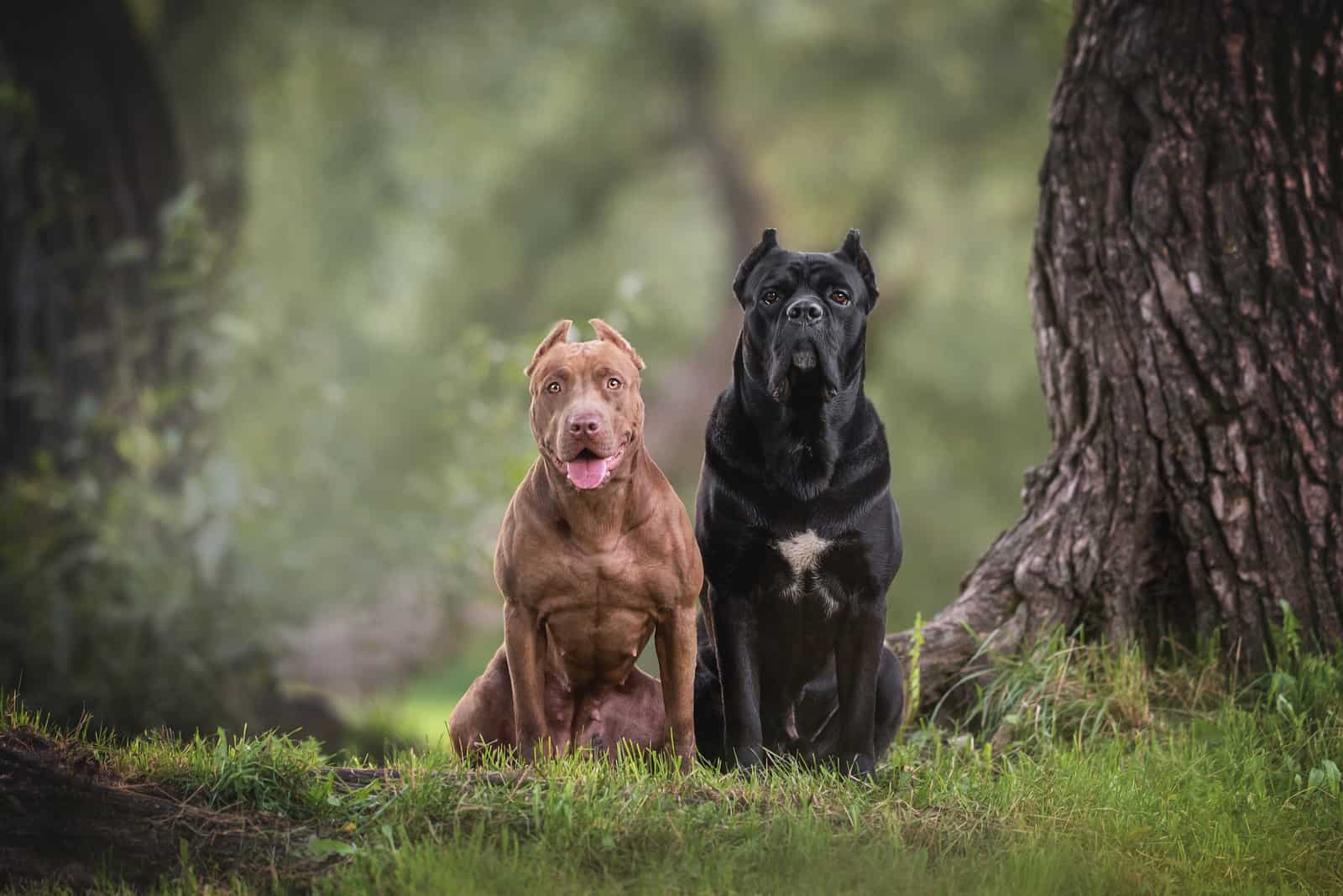Let’s be clear from the start: This is a guide that compares the two breeds, not a sick quest to explore which would win in a fight. Dogfighting is a deplorable activity supported by criminals and despicable human beings who enjoy the barbaric spectacle of seeing dogs tearing each other to pieces.
It is illegal in all forward-thinking countries in the developed world, and rightly so. If you came here looking for gruesome facts about dogfighting, we’re happy to say that you’ll be very disappointed.
Now we’ve got that out of the way, let’s take an in-depth look at these two amazing breeds in our Cane Corso vs. Pitbull quest to discover the differences and similarities!
We’ll begin with an overview and a bit of background information on each breed.
The Cane Corso
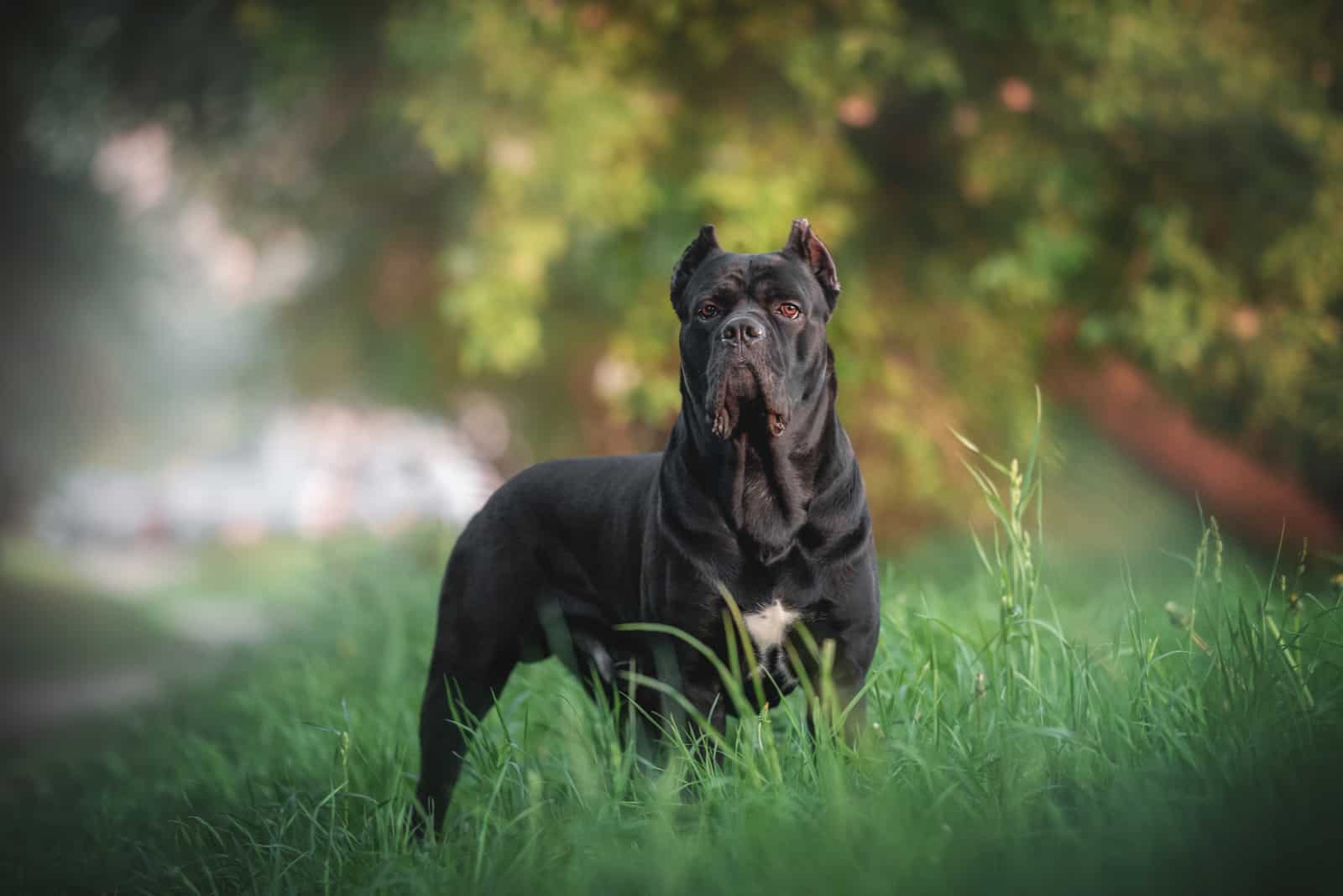
Also known as the Italian Mastiff, the Cane Corso is a powerful beast, originally bred as a working dog. They acted as guard dogs, protecting livestock and remote farmsteads from bandits and wild animals, as well as rounding up and herding cattle or pigs to market. Some dogs assisted in hunting large game.
They also made excellent companions, forming a close bond with their families.
Their name comes from the Latin Cane, meaning dog, and Corso, which could either mean ‘guardian’ or ‘robust.’ Both meanings are equally appropriate!
These dogs are thought to be descendants of the Molosser breeds of ancient Rome, meaning that the Cane Corso breed has a long history stretching back more than 2,000 years. They were huge, fearsome creatures that joined the Roman army as war dogs, striking fear into the enemies of Rome.
Eventually, after the fall of the Roman Empire, they found a role in the agricultural landscapes of southern Italy, where they became a familiar sight for centuries as they protected livestock and farms. They were still fearsome when required but gentle and placid around their owners and the other beasts.
However, the dog we see today is the product of selective breeding during the 1980s, as the Cane Corso had almost become extinct by that time due to the increased mechanization of farming methods.
The American Pitbull Terrier
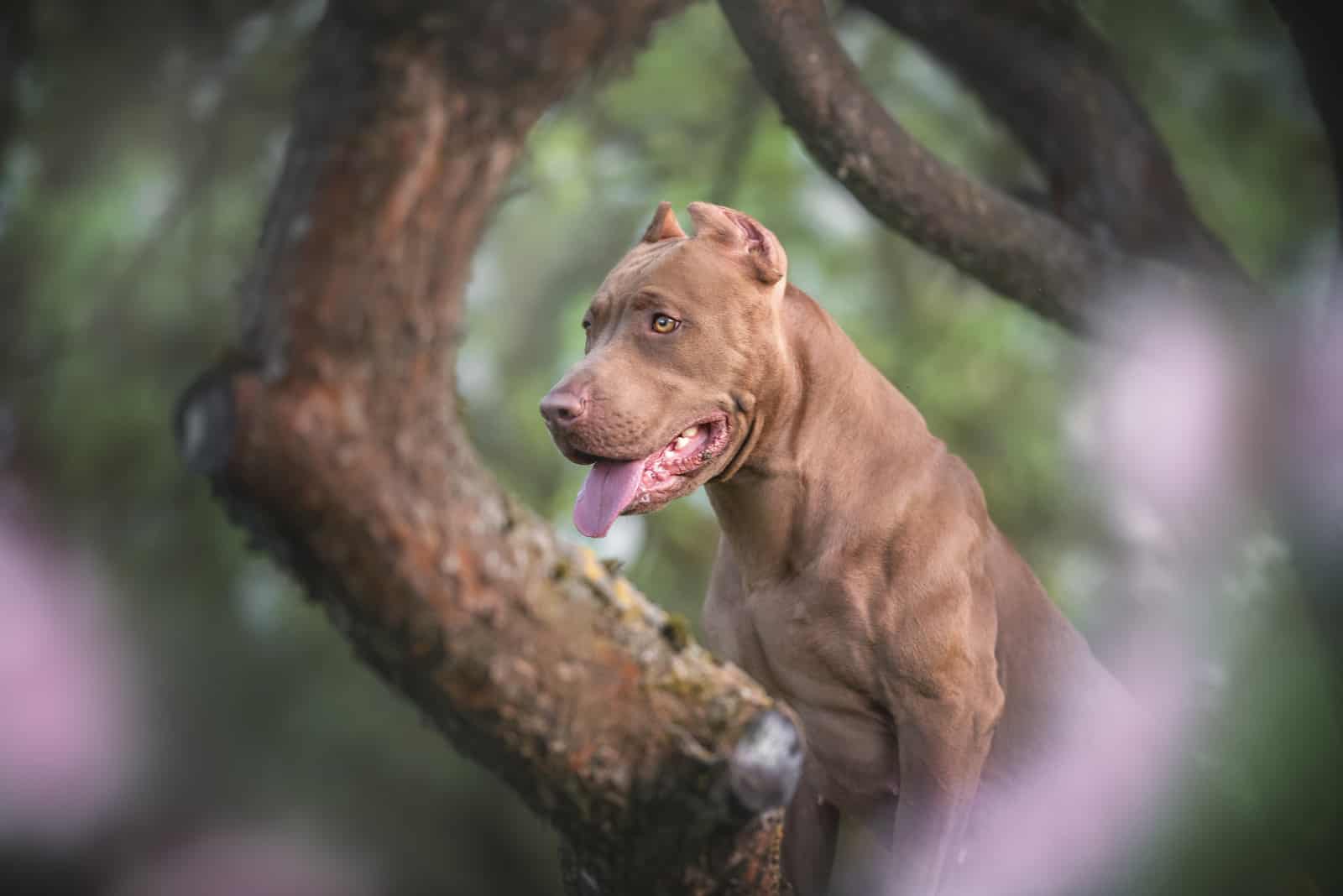
Also known as the Pitbull (or Pit Bull), this dog has been the subject of debate and controversy for decades. We’ll look at the term Pitbull in more detail later, but just to be clear, we are referring to the American Pitbull Terrier in this article.
The sad fact is, the dogs themselves are largely blameless. When you look at the facts, including the highly arbitrary and misleading dog bite statistics, you’ll realize that humans are to blame in most cases.
The American Pitbull’s history as a fighting dog doesn’t help matters: the name Pit Bull comes from the days when dogs were placed in a small arena (the pit) where they fought against a range of large beasts, such as bulls and bears (and in some cases, rats). Wagers were placed on each dog to see which would last the longest or bring down the unfortunate animal.
This led to breeds like the English Bulldog and the Bull Terrier, from which all of the later Pit Bull breeds came. When the appalling ‘sport’ of bull/bear-baiting was eventually outlawed in England in 1835, people began to breed smaller, more powerful dogs that were set against each other.
The ancestors of the American Pitbull arrived in America in the mid-1800s, where they continued their role in dogfighting, although they were also used on farms and ranches, herding livestock and hunting hogs. They also became highly valued as loyal companions. The breed was recognized by the United Kennel Club (UKC) in 1898 when it was officially named the American Pitbull Terrier.
Thankfully, we now (mostly) live in more enlightened times, although dogfighting sadly still remains popular in some countries, including the U.S. The American Pitbull is used extensively in this evil practice, and criminal elements frequently use them as a means of protection against law enforcement.
Despite this, the American Pitbull Terrier is a loveable, fun-loving companion that adores its owners and is generally friendly. As with most breeds, it’s important to train and socialize them as pups, as this helps eliminate any problems later. Even so, some Pitbulls (especially males) aren’t great around other dogs, so you may need to keep them on the leash.
One way to ensure you get an even-tempered dog is to use a reputable breeder. If you select your dog from a breeder that has produced fighting lines, or you buy from a stranger on Craigslist, you’re asking for trouble.
Are Cane Corso And Pitbulls Related?
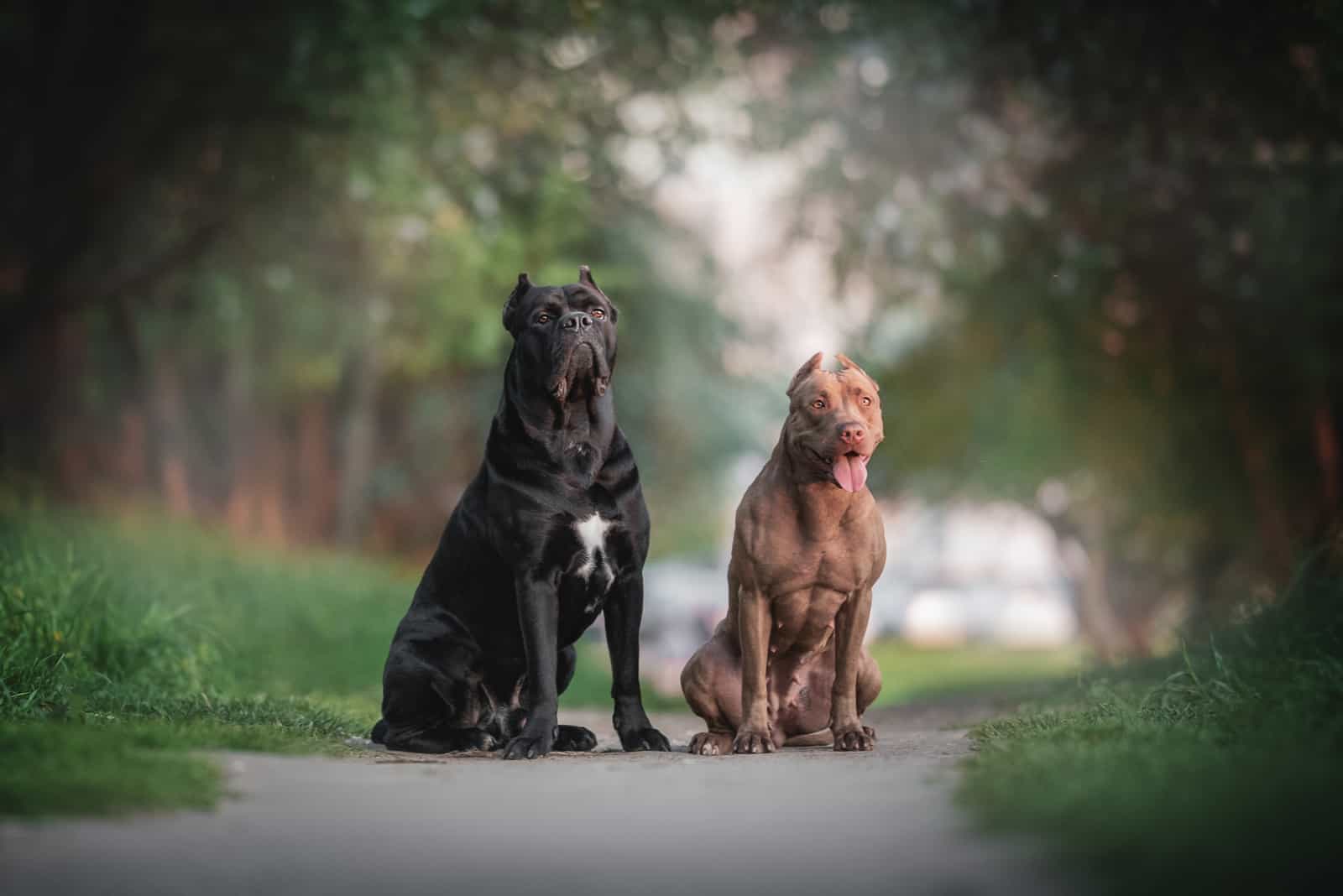
First of all, the plural of Cane Corso is Cane Corsi.
Second, there’s a lot of confusion about the term Pit Bull.
In short, the answer to the above question is no, they are not related. As with all domesticated dogs, they share a common ancestry with the Gray Wolf (and more than 99% identical in terms of their DNA), and some Pitbulls may have Cane Corso blood because of interbreeding, but that’s as close as they get to being related.
The Cane Corso is a type of Mastiff dog, while all Pitbull-type dogs originated from the Old English Bulldog and Old English Terrier, both of which are now extinct. As we saw above, they were developed for the blood sport of bull-baiting and dogfighting.
When bull-baiting became illegal, breeders started producing smaller dogs based on the Bulldog, resulting in a range of different breeds often referred to as Pit Bull dogs.
These include the following:
• The Staffordshire Bull Terrier (known as the Staffie)
• The Bull Terrier
• The American Bully (not to be confused with the American Bulldog, which is not usually considered a Pitbull type!)
• The American Staffordshire Terrier (sometimes called the AmStaff)
• The American Pitbull Terrier (APBT)
Many people believe that the Pit Bull is an actual breed, but this is not true! Some of the confusion lies in the fact that the American Pitbull Terrier is frequently referred to as the Pit Bull. This common error has resulted in mistaken identity in cases of dog attacks, which reflects badly on the dog and has led to breed-specific legislation. As a result, the American Pitbull Terrier is restricted or banned in many countries, including the U.K.
Laws in the U.K. are so strict that dogs have been destroyed just because they look like an APBT, even if they have no record of violent or aggressive behavior!
Although the situation is generally better in the U.S., several states have restrictions or outright bans on Pit Bull dogs.
Incidentally, the Cane Corso, while legal in the U.K., is banned in these states in America:
• Nebraska
• Louisiana
• Kansas
• Iowa
• Missouri
• New Mexico
• Arkansas
• Montana
These bans are mostly based on isolated incidents involving dog bites.
The merits of breed-specific legislation are questionable, but until a better, fairer system is established, dog owners will just have to cope as best they can.
Now let’s continue our study of the Cane Corso vs. Pitbull to see what else we can discover!
Cane Corso Vs. Pitbull: Size
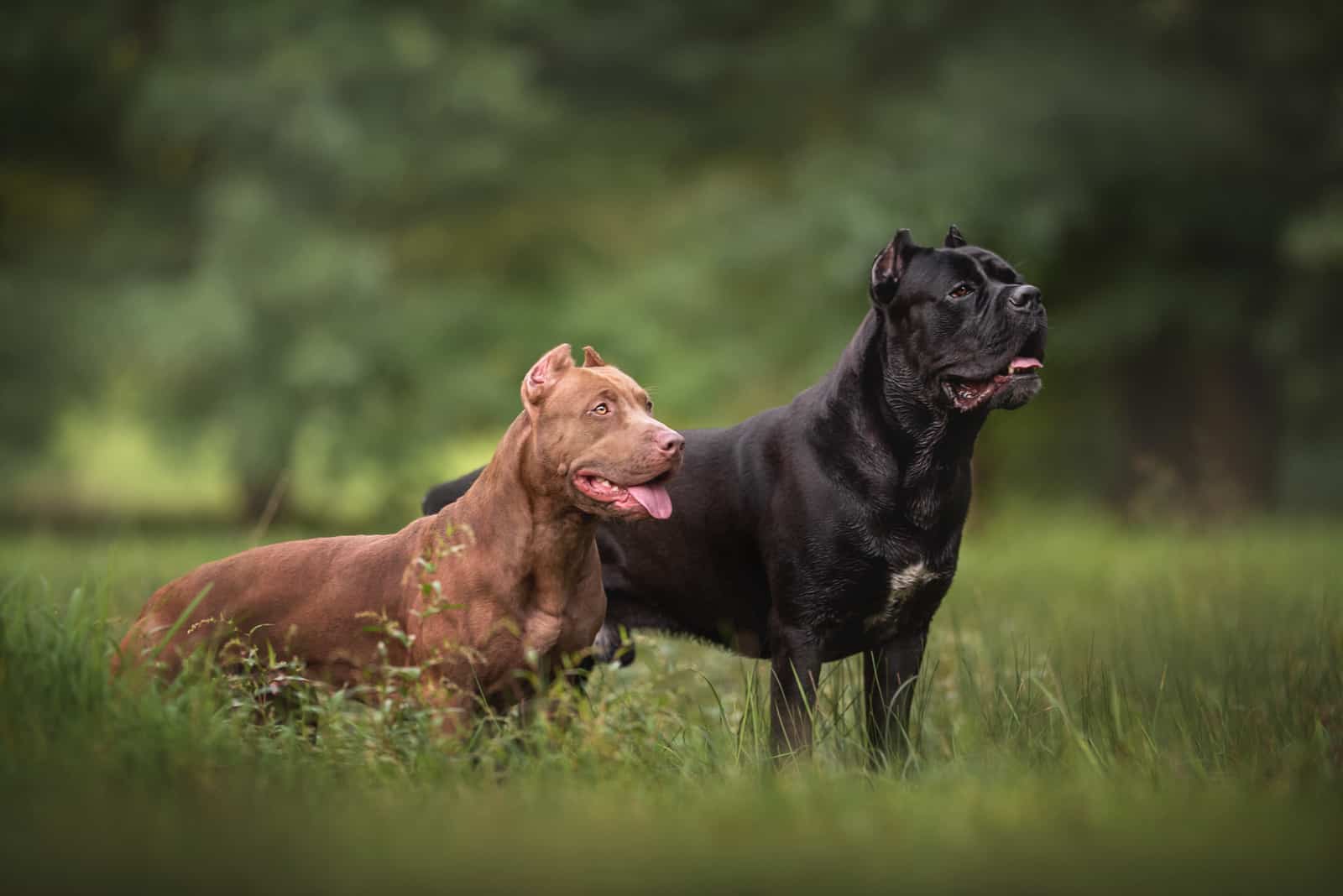
The Cane Corso is the winner here, measuring between 25 and 27.5 inches at the withers (shoulders), while the APBT stands at between 17 and 19 inches at the withers.
In terms of weight, the difference is even greater: the mighty Cane Corso weighs in at between 90 and 120 pounds, whereas the American Pitbull weighs between 30 and 85 pounds.
So, in terms of Cane Corso vs. Pitbull, the former is much larger and heavier.
Related article: Pitbull Growth Chart
Cane Corso Vs. Pitbull: Bite Force
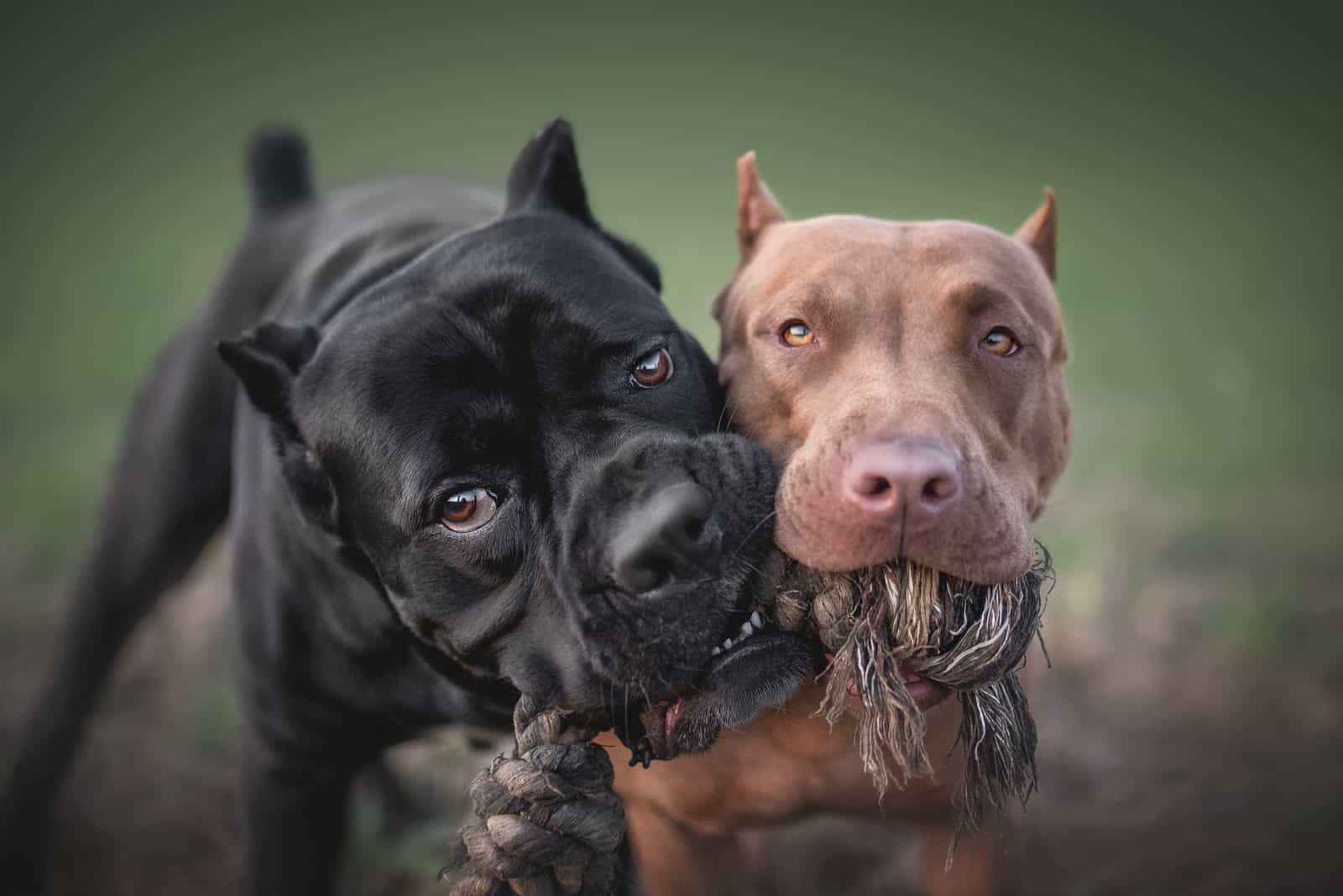
You may wonder why we’ve included this subject, seeing how strongly we set out our intentions at the beginning.
However, bite force is an important factor to keep in mind when you are considering getting a large, powerful dog of any kind. Small dogs can cause a lot of damage and are often far more aggressive. With a big dog, it often only takes one bite to land you in hospital!
So, what about bite force when it comes to Cane Corso vs. Pitbull?
It may not be a surprise to learn that the Cane Corso wins here, too. Even so, you may well be surprised just how much the difference is: The Cane Corso has a bite force of around 700 PSI* (pounds of force per square inch), while the APBT comes in at around 235 PSI, which is about average for most dogs of their size!
The Cabe Corso’s massive jaws are significantly more powerful than the American Pitbull, which is one of the main reasons for legislation against this dog.
When you look at this logically, it doesn’t make much sense. Any dog can potentially be aggressive, and millions of dog owners have been bitten by their own pooches at various times. Rather than banning or restricting certain breeds, perhaps it would be better to educate people about dog ownership, using reputable breeders, and proper training and socialization of their pups?
*few dogs have a bite force greater than this. The Kangal (or Anatolian Shepherd Dog) is one, with a bite force of around 743 PSI.
Cane Corso Vs. Pitbull: Health Problems
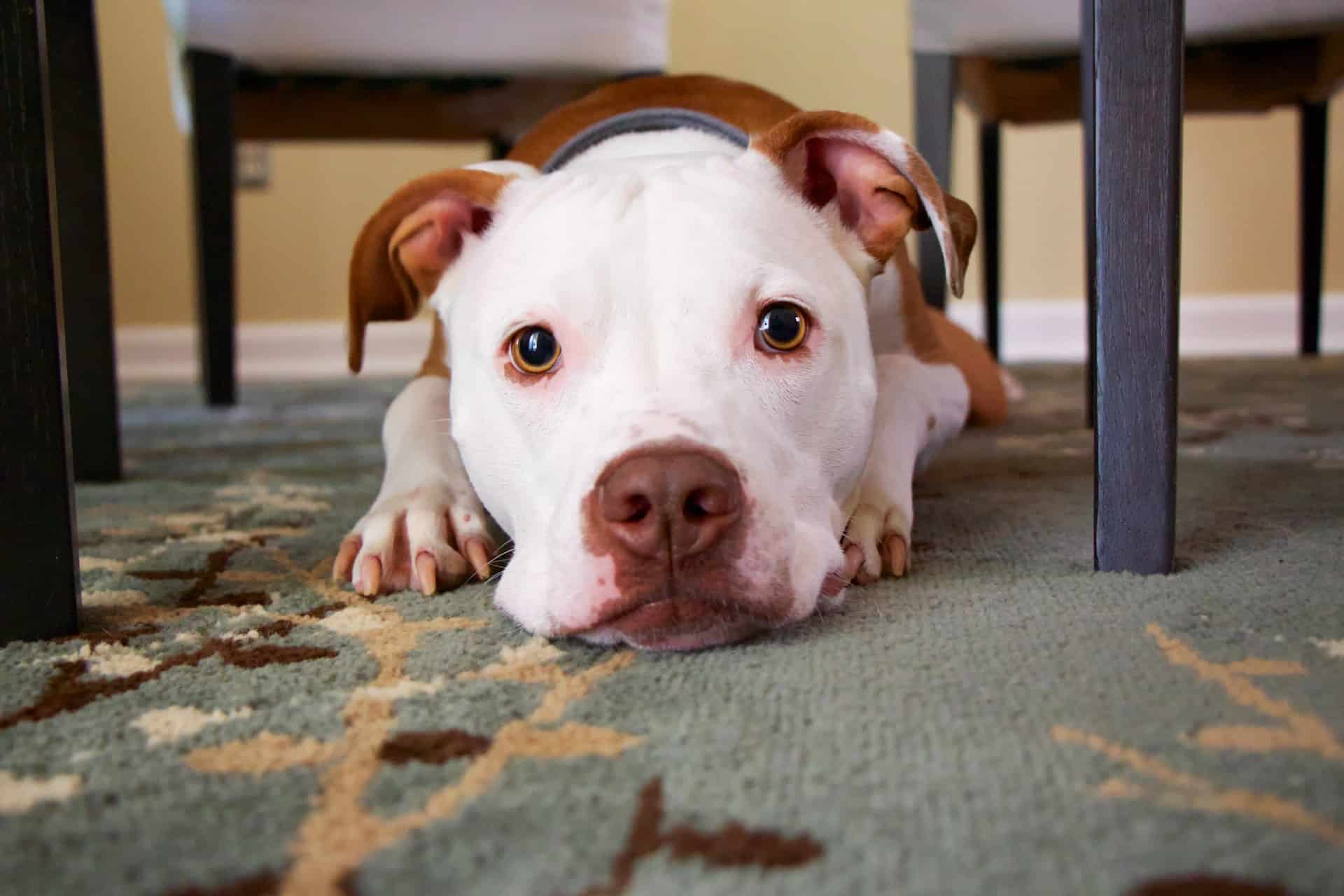
All dog breeds face common health issues, some more than others. But how do the two breeds fare in the Cane Corso vs. Pitbull debate?
Cane Corso
• Hip dysplasia (a faulty joint that causes the bones to rub together, often leading to arthritis)
• Elbow dysplasia (similar to the above, but in the elbow joint)
• Cherry eye (prolapsed third eyelid gland)
• Entropion/ectropion (the hairs on the eyelid turn out/inward, scraping on the skin or the cornea, which can lead to irritation and ulcers)
• Mange
• Cancer
• Allergies
• GDV (gastric-dilatation volvulus, also known as bloat or gastric torsion, is a condition where the stomach inflates and twists around, cutting off the blood flow to vital organs. This can be fatal if not treated in time, mostly affecting large breed dogs with deep chest cavities)
American Pitbull
• Hip dysplasia
• Luxating patella (dislocating kneecap)
• Thyroid problems
• Degenerative myelopathy (DM is a progressive spinal cord disease that eventually causes paralysis)
• Mange
• Congenital heart conditions
• Skin allergies
Hip dysplasia is common in many dog breeds, especially larger ones. All reputable breeders run screening programs to reduce the risk of their pups having the condition, but it still remains a problem in many purebred dogs.
Other than this, the biggest threats are bloat and cancer in the Cane Corso and DM and heart problems in the Pitbull.
Cane Corso Vs. Pitbull: Lifespan
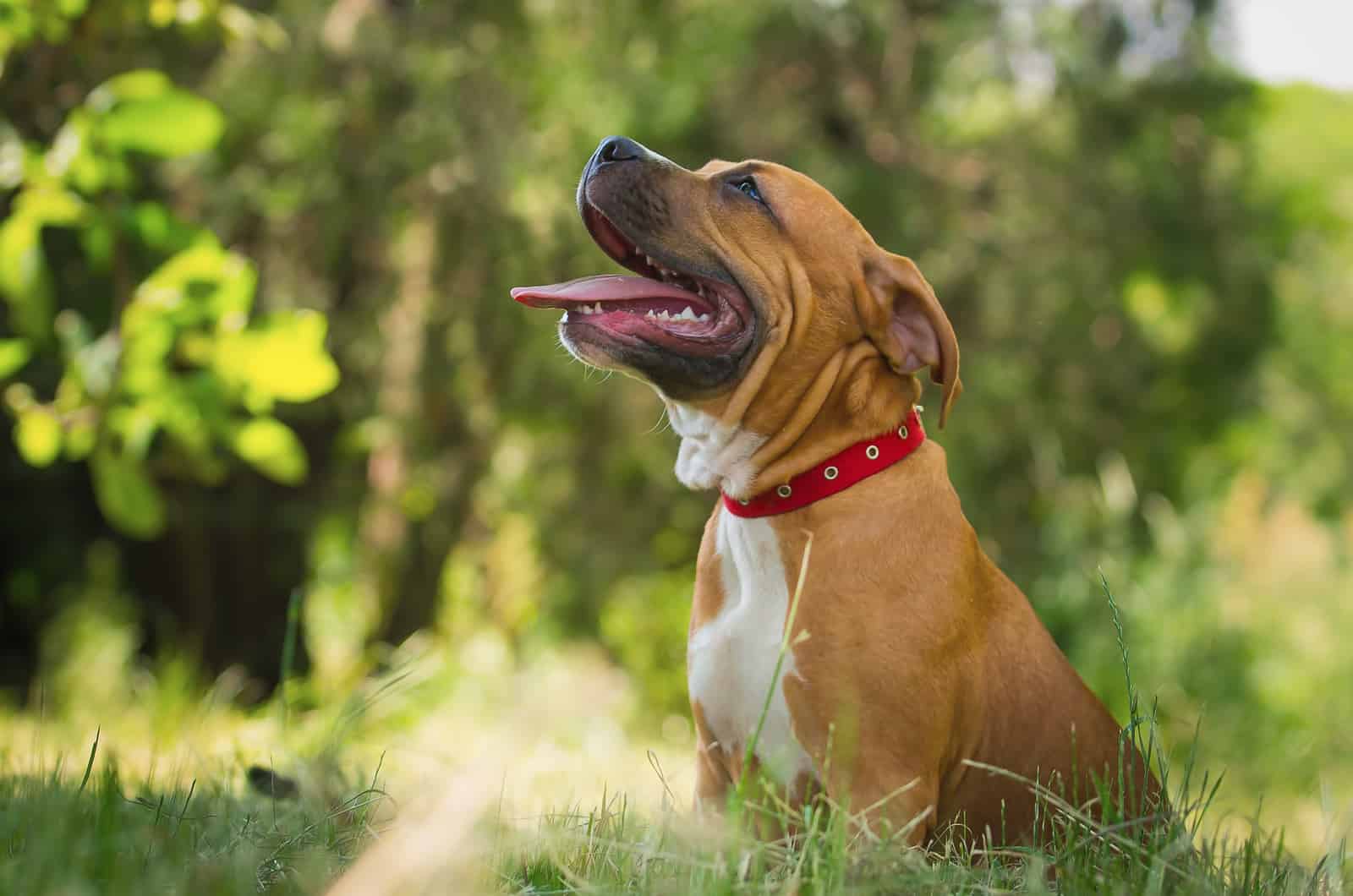
It’s not what you want to dwell on when you get a happy little puppy scampering around your feet, but it’s an unpleasant fact that your furry friend won’t live forever.
Because of this, it’s good to have a rough idea of how long they are going to be with you.
So, what about the Cane Corso vs. Pitbull? How long does each breed live?
Well, the figures are a bit unusual!
The Cane Corso has an average lifespan of between 10 and 12 years, which is pretty good for a dog of this size. By comparison, the English Mastiff has a lifespan of between 6 and 12 years, and the Great Dane and the Rottweiler are between 8 and 10 years.
Large dogs generally tend to live shorter lives than small dogs. The reasons for this aren’t fully understood, although it is believed to do with the need for rapid development as pups. This accelerated growth rate affects their metabolism, speeding up the aging process significantly. So, if your Corso has lived for more than 10 years, they’re doing very well!
As for the American Pitbull Terrier, they can live for between 12 to 14 years, although some sources put this figure between 8 and 15 years. The average American Pitbull lives for around 12 years, which is about right for a dog of its size.
Once again, you can play your part in increasing your dog’s longevity by using a reputable breeder, feeding your pooch good quality dog food, and getting regular health checks at the vet. Exercise and mental stimulation will also help them to stay healthy and happy.
Ideally, choose a breeder that uses the Super Puppy program of Early Neurological Stimulation, as this boosts their chances of living a long, healthy life.
Cane Corso Vs. Pitbull: Cost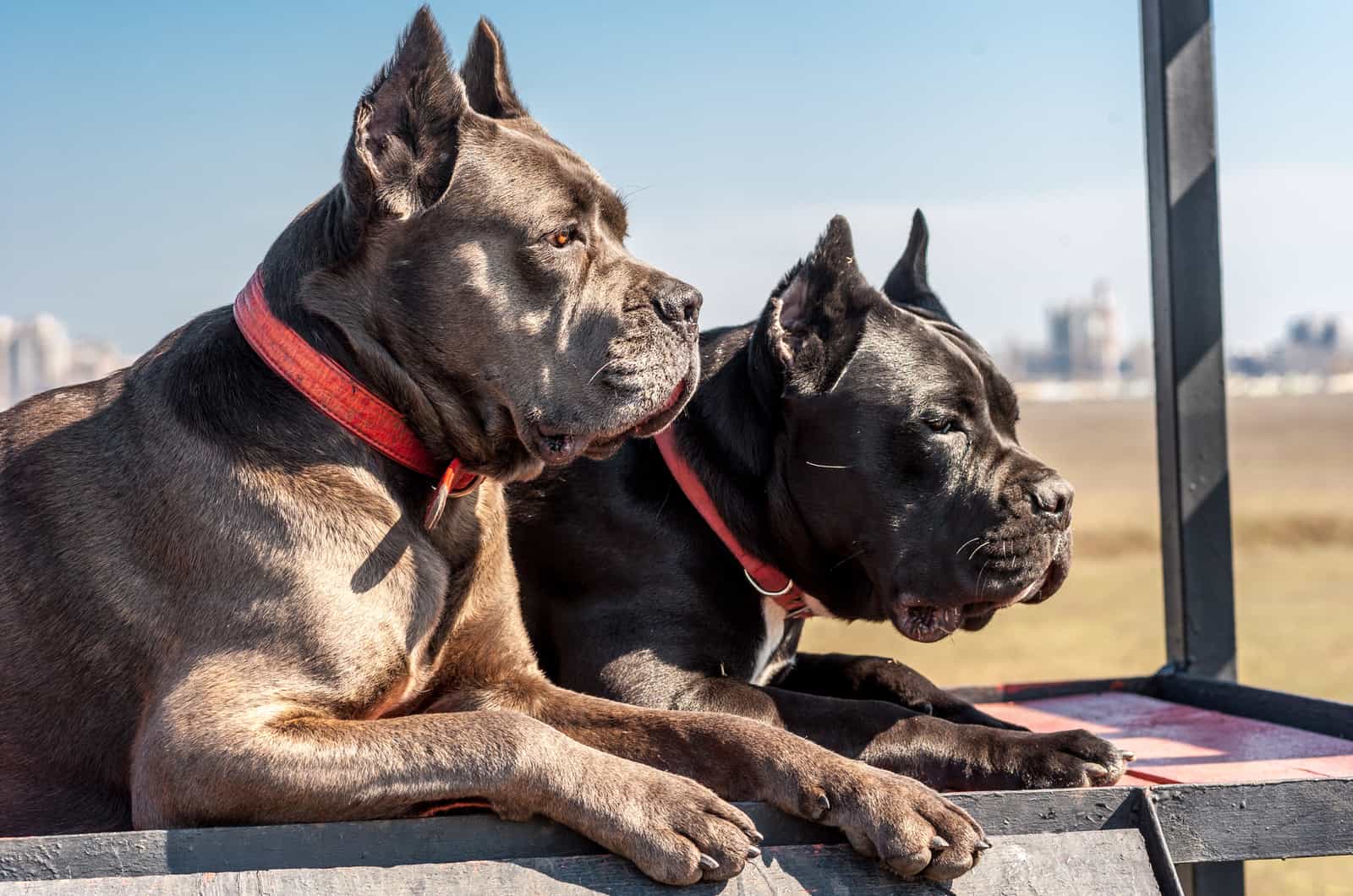
On average, a Cane Corso puppy will cost between $1,000 and $2,500, depending on the breeder, your location, and the sex of your pup. For superior lines, you should expect to pay between $3,000 and $5,000.
The average cost of an American Pitbull Terrier is $1,100, but you might have to pay between $3,500 and $10,000 for a dog from a championship bloodline or a rare dog, such as a blue or bluenose Pitbull.
The best advice is to avoid breeders that use the term ‘rare’ to sell any dog. Good breeders may charge more for certain animals, but they certainly won’t play on the term and use it as a marketing ploy.
Bear in mind when you buy your pup that a lot of time, effort, and money has gone into producing it. A reputable breeder will pay between $3,000 and $5,000 (maybe more) to produce each litter. And that doesn’t include any other overheads.
So, in relation to Cane Corso vs. Pitbull, there’s not much between them if you opt for a standard, pet-quality dog. The prices for both will rise steeply if you select a dog from championship bloodlines or one of the rarer colors.
Cane Corso Vs. Pitbull: The Best Family Pet?
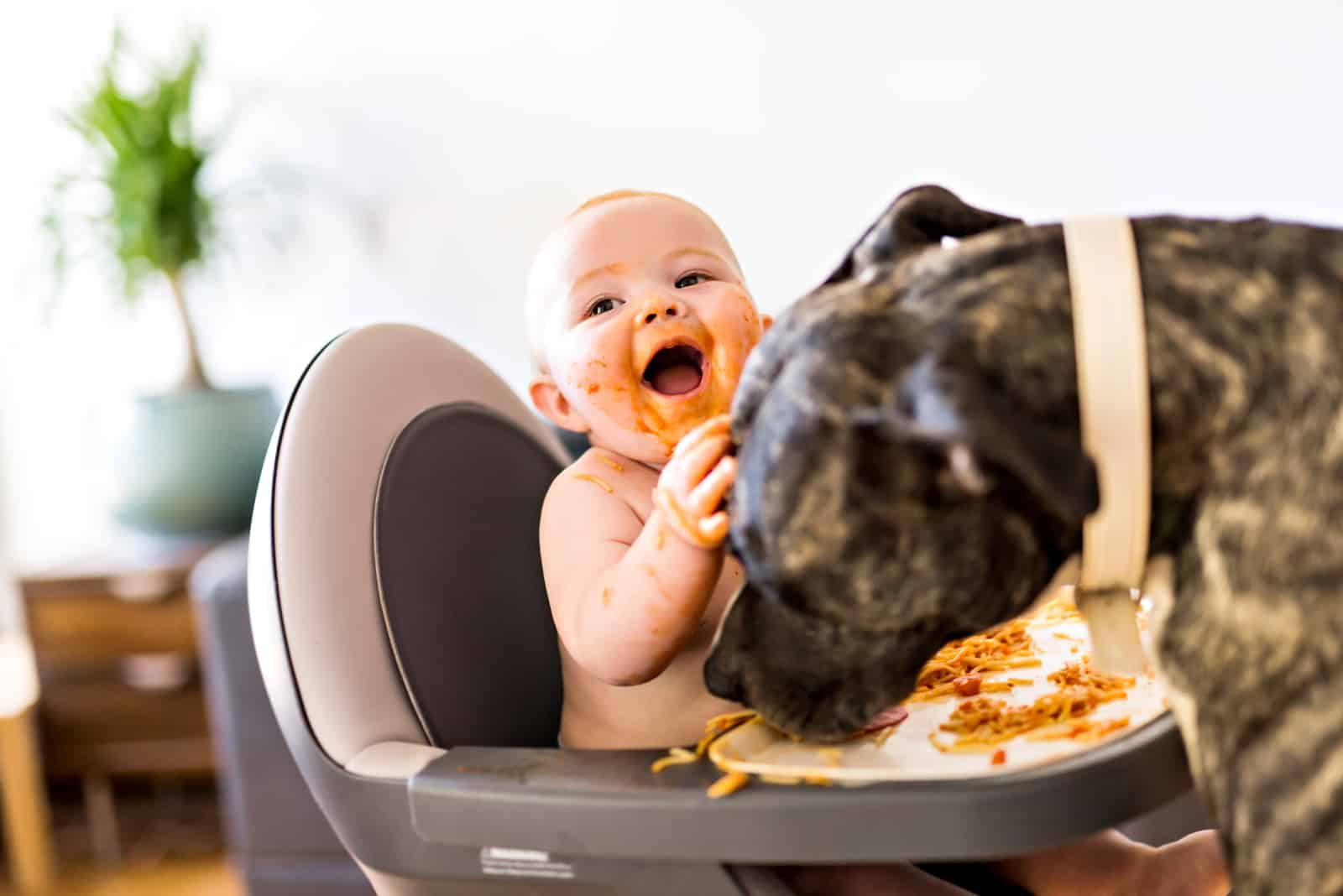
Whatever their history and background, both of these breeds are kept as family dogs. Admittedly, the Cane Corso is more likely to double as a protection dog, warding off intruders or keeping livestock safe in remote country regions, but it is still valued as a family companion.
Let’s look at the two breeds in detail to see which is the best family pet in our examination of Cane Corso vs. Pitbull.
Cane Corso
As we know, this is a large dog, so you need to have room for it. Your yard will need a secure fence at least 6 ft high to keep your dog contained.
These dogs are calm, reserved, intelligent, and headstrong. They require an assertive owner who always takes the upper hand, or they will try to assume dominance. Thankfully, they are very trainable, and this process must be started as early as possible if you want to succeed.
Although they love their families and are 100% loyal, they don’t often openly show affection like other dogs. Some dogs are happy to sit by you, and that’s enough for them. Don’t always expect a lot of cuddles with this dog, as they’re just not built this way!
This doesn’t mean that they aren’t capable of affection. They will show affection, just in their own way and when it suits them. Despite their size, they are gentle with kids and will become extremely protective of them. Not only are they highly intelligent, but they are also uncannily sensitive to your mood. They will detect the slightest change and react accordingly.
One word of warning: this is not a dog that does well in a home where even one person does not like dogs or is afraid of them! They will sense this and single that person out, treating them with suspicion. They may even be openly hostile toward them at times.
The Cane Corso does not generally trust strangers or other dogs. They have a high prey drive and have been known to chase and kill cats.
Don’t expect them to take to strangers in the home, either. You will have to introduce the visitor slowly and allow the dog to get used to them.
Even so, if they suspect that the visitor is a threat, they will warn them, often by nudging them away from a family member.
The best way to limit this behavior is by thorough, consistent socialization when the dog is a pup and throughout its life.
As you might expect, this is not a good choice for first-time dog owners!
American Pitbull Terrier
The APBT is a much more social animal than the Cane Corso. The image of a snarling beast, more suited to the fighting arena than the family home, is far from the truth – in most cases.
These dogs are big softies, for the most part. They love to romp with kids – nothing makes them happier than playing in the yard with children! They love to play the clown and will spend hours chasing and tumbling around. It’s fair to say that the kids usually tire out long before the dogs!
As well as being clowns, American Pitbulls are no-nonsense dogs with a sense of quiet confidence. Contrary to popular belief, they are rarely the aggressor in a fight. However, once their fighting instinct is aroused, they will not back down. Any dog that picks a fight with even the gentlest Pittie will probably regret doing so.
In general, Pitties are very accepting of strangers and tolerant of other dogs. They can be stubborn, but with the right training, they will soon get with the program! You must be firm and assertive, but use gentle encouragement to get the best results.
The key to getting a Pitbull with the right temperament is to be very careful where you buy from. As we’ve learned, certain breeds are still used for fighting, and if you buy from a disreputable source, there’s a real danger of getting a poorly-bred, aggressive animal that will have health issues.
Only approach respected, reputable breeders and avoid using anything that looks like a puppy mill, puppy broker, or backyard breeder. You should also avoid buying online from social media or sites like Craigslist, as these are well-known for being outlets for puppy mills.
Cane Corso Vs. Pitbull: Energy Level
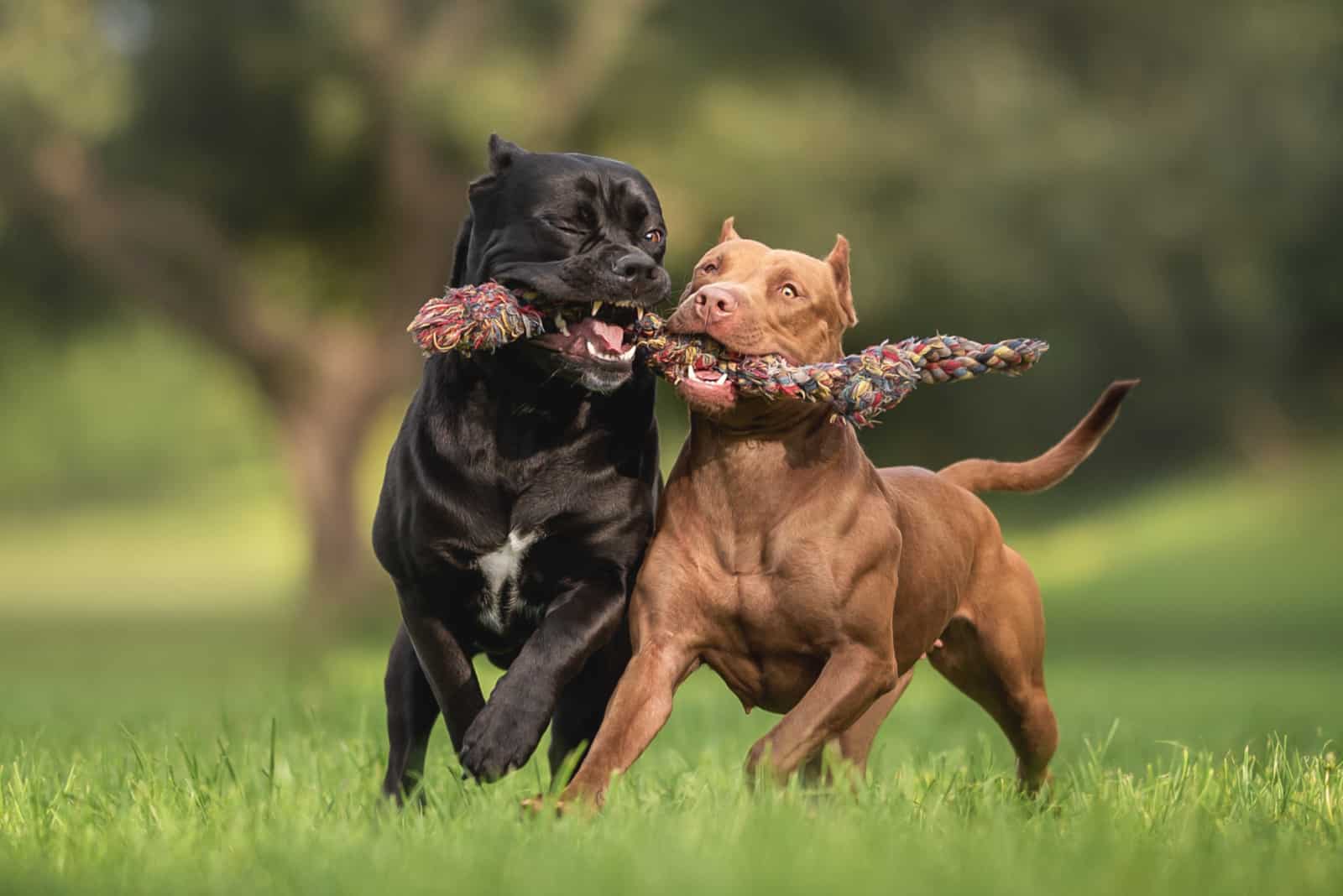
Although both are muscular, powerful dogs, the Cane Corso doesn’t need as much daily exercise as the American Pitbull. Cane Corsi keep active throughout the day, pacing around the yard or the home. This is a natural guarding instinct, and they are never content to lay around the house all day.
The average Cane Corso needs around two hours of daily exercise, including brisk walks and jogs, as well as short training sessions.
On the other hand, the Pitbull is an active, high-energy dog that needs to run and play. They require between one and two hours of exercise each day. Playtime can be too rough for some dogs, as the poor Pittie doesn’t know its own strength. They are all muscle, so a vigorous and enthusiastic playtime can sometimes end with smaller dogs being hurt.
Both dogs have a high prey drive, so they may chase after small animals. It’s never a good idea to let them off the leash in public areas, and some cities and states have strict laws on such matters, so it’s always best to check these out.
It is essential that you meet their exercise needs. Letting them out in a secure yard to run about by themselves is okay, but they need mental stimulation as well. This means you need to set them trials and challenges that will test their wits. They love to interact with you, strengthening the bond of trust and love between you and your dog.
Taking them out on walks is great for stimulation, especially if you can find new places to visit. Dogs use their noses to explore and understand the world, and new smells, sights, and sounds are all exciting experiences for them.
Without proper exercise and stimulation, both breeds will become frustrated, bored, and potentially aggressive. You can expect a lot of unwanted behavior, such as digging up your yard, chewing up your home, and barking excessively.
Cane Corso Vs. Pitbull: Coat Type And Color
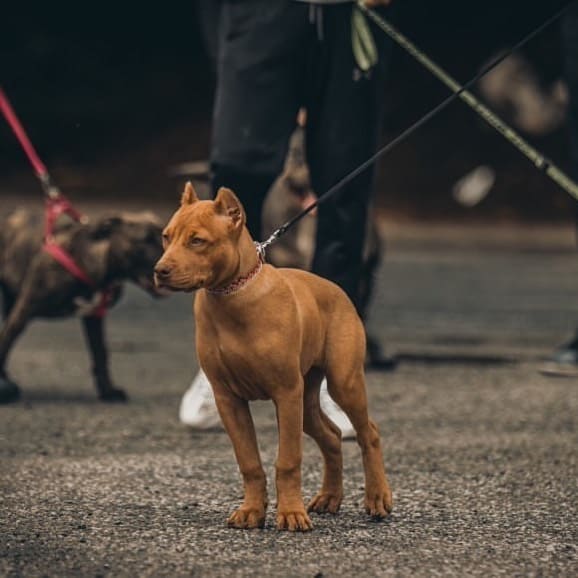
Photo from: @ghosthousebullyz
The APBT has a short, stiff, shiny coat that comes in all colors, including:
• Red
• Brindle
• Black
• White
• Blue
• Gray
• Brown
Grooming is pretty straightforward as you can get away with a quick daily brush to get rid of loose hairs. You should bathe them occasionally and give the coat a wipe down to keep it clean and healthy.
Many people are surprised to learn that the Cane Corso’s short, coarse coat doesn’t just come in black! This is a popular color, possibly because it is so impressively menacing. However, they also come in the following colors:
• Gray
• Gray brindle
• Red
• Chestnut
• Black brindle
• Fawn
These can have a black or gray mask.
You’ll also sometimes see blue, formentino (blue fawn), chocolate/liver, and isabella (tawny) dogs advertised, but these are rare colors that are not part of the American Kennel Club (AKC) breed standards. Because of the complexities of dog coat color genetics, some experts believe that the genes responsible for certain colors also cause health problems, usually connected with eyesight and hearing.
The Cane Corso needs brushing once a week to keep the coat in good condition. You might want to increase this to a daily brush during shedding season.
Cane Corso Pitbull Mix Puppies
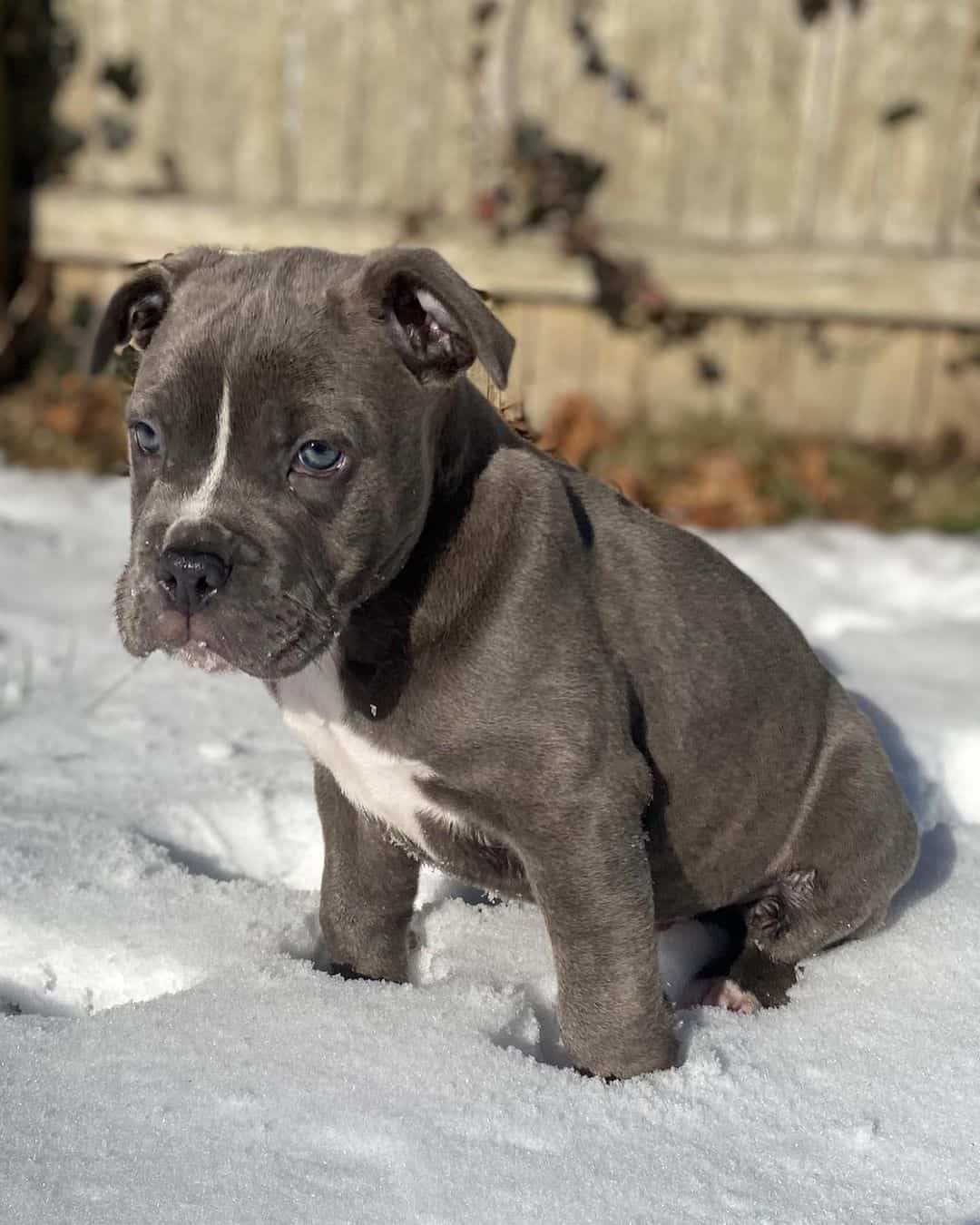
Photo from: @meli_mel_pitcorso2
Hybrid dogs are all the rage these days, with new designer dogs appearing all the time. One of these might interest dog lovers who can’t choose between the Cane Corso or the APBT, and this is the Cane Corso Pitbull mix!
Known as the American Pit Corso, these puppies are absolutely adorable. They have the happy, friendly, affectionate nature of Pittie, along with the guarding instinct of the Corso.
They are excellent with kids, but they may have a natural wariness of other dogs.
As for the size of your pup when it reaches adulthood, estimates vary from between 50 and 90 pounds, or 75 and 115 pounds! They will measure somewhere between 20 and 34 inches at the shoulder.
Crossbreeding is a complex issue that should only be undertaken by experienced breeders. Even then, the results can be unpredictable. At best, you take all the positive aspects from both breeds and create one beautiful, well-adjusted dog. However, it is also possible that some unwanted traits will make their way through.
With the Pit Corso, there may be a tendency toward stubbornness. Both breeds have this in spades, so you’ll need to persevere with training and socialization at the earliest opportunity.
Other than this, the American Pit Corso is an amazing dog. It has the Pittie’s natural charm and sense of fun, with the bulk and seriousness of the Corso on top.
The Winner
In our study of Cane Corso vs. Pitbull, we’ve learned a lot about both of these popular breeds. Each one faces discrimination and prejudice based mostly on fear and ignorance. Anyone who knows these dogs will understand the unfairness of this situation. However, this doesn’t change the fact that they are amazing animals.
So, who is the winner?
Well, that’s not really up to us to say! You’ve seen all the information, so the ball is in your court. It all depends on which one appeals the most and whether you are up to the challenges each one presents.
If you like the idea of a large dog that will double as a loyal guardian, then the Cane Corso might be the dog for you. You’ll need to commit to obedience training and thorough socialization. You must make sure they get the exercise and mental stimulation they need. It isn’t the cuddliest dog, but it is affectionate (unlike, say, the Presa Canario!). They tend to share their love among the family, rather than focus that attention on one caregiver, just like the German Shepherd and Doberman. Any affection they give will be on their terms!
Related: Cane Corso vs. Doberman
This is a naturally suspicious dog that doesn’t tolerate strangers or other dogs very well. You will need to be on your guard all the time, as they will never be off duty.
Alternatively, if you want a goofy clown that loves everyone and wants to play all day, then the American Pitbull Terrier is the right choice.
However, it’s not without its challenges. Once again, you must get them properly trained and socialized as this will help you to keep them under control. They do have a serious side and can be protective of their families.
The biggest problem is public perception, and there’s a chance that you’ll face hostility and prejudice because of your dog’s looks. To be fair, the same could be said of the Cane Corso.
One thing that could go a long way to reducing public animosity toward these breeds is if breeders stopped the cruel and unnecessary practice of ear cropping. This gives these dogs a vicious, aggressive appearance, instantly adding to public paranoia.
Despite the claims of breed enthusiasts and kennel clubs, there is absolutely no evidence to suggest that ear cropping offers any benefits whatsoever. It is entirely cosmetic and comes down to personal preference.
Ear cropping has been banned in many countries because of this, and it is probably only a matter of time before the U.S. catches up.
So, by using reputable breeders and by keeping the breeds’ natural, softer look, we can give them a brighter future where they’ll be better accepted and released from restrictions.
Finally, if you can’t make up your mind between the two, you might want to consider a mix of the two: the Cane Corso Pitbull, which gives you the best of both breeds!
Read Next: Top 7 Pitbull Breeders In Ohio: Get Your Nanny Dog From ‘Em
